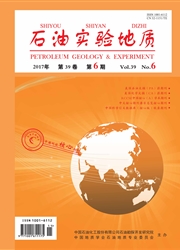

 中文摘要:
中文摘要:
震旦纪是塔里木盆地被动大陆边缘盆地重要的发育期。通过对阿克苏肖尔布拉克剖面上震旦统奇格布拉克组的实测及综合分析认为:奇格布拉克组的底、顶部分别发育Ⅲ级沉积间断的岩相转换面和Ⅱ级海侵上超层序不整合界面;内部发育加深间断面、向上变浅的Ⅳ至Ⅴ级层序界面,发育了受海平面变化控制的环潮型(向上变浅、变细、变薄)至潮下型(向上变浅、变粗、变厚)的碳酸盐岩米级旋回,叠层石相对发育,可能由多种形态的微生物席构成。奇格布拉克组可划分为下、中、上3个岩性段:其中,下亚段为潮上至潮间、潮间下部至潮间、潮间至潮上的振荡变化,中段为潮间下部至潮下带的频繁、振荡变化至潮下稳定的沉积环境;对应的碳同位素呈底部较强烈正偏,中上部较为稳定,且上部稍弱正偏的特征;海平面具有下部频繁变动、中上部稳定下降的变化趋势。
 英文摘要:
英文摘要:
Sinian is one of the most important stages of the development of passive continental margin basin in the Tarim Basin. Based on the measurement and analysis of profiles of the Qigebulak Formation (Z2g) of the upper Sinian at Xianerbulak of Aksu, it has been concluded that theⅢ-order sequence boundary surfaces with hiatus and lithofacies transition and theⅡ-order surfaces with transgressive onlap and sequence unconformity interface develop at the bottom and on the top of the Qigebulak Formation, respectively. In the middle of the formation, deepening interruption surface and shallowing-upwardⅣ-Ⅴsequences develop. The Milankovitch cycle of carbonate rocks has been found, under either peritidal ( becoming shallow, fine-grained and thin upwards) or subtidal ( becom-ing shallow, coarse-grained and thick upwards) environments controlled by sea level changes. Stromatolites are widespread, mainly consisting of various microbial mats. The Qigebulak Formation can be divided into 3 lithologic sections from bottom to top, among which the lower section changes from supratidal to intertidal, the lower part of intertidal to intertidal, and intertidal to supratidal; the middle section is characterized by the frequent variation from the lower part of intertidal to subtidal and the stable environment of subtidal. Carbon isotopes are strongly positive at the bottom, stable in the middle and upper sections, and weakly positive at the top. Sea levels change frequently at the bottom, and stably decrease in the middle and upper sections.
 同期刊论文项目
同期刊论文项目
 同项目期刊论文
同项目期刊论文
 期刊信息
期刊信息
